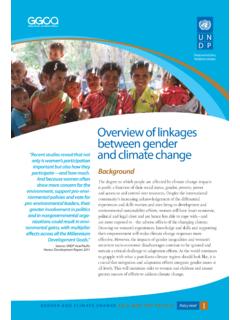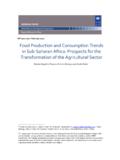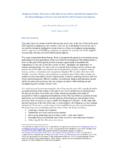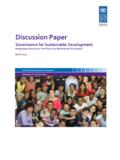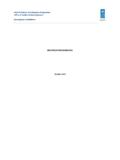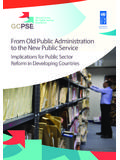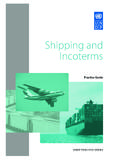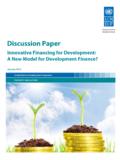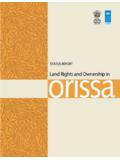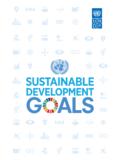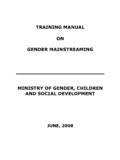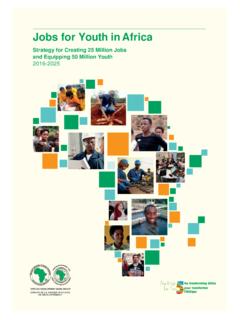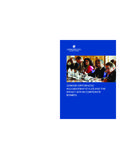Transcription of Gender and Disasters - UNDP
1 Bureau for Crisis Prevention and Recovery Gender and Disasters Both women and men are part of the same society, which, as we know, does not mean we have the same rights, education and options to manage, neither in normal' times, nor when a disaster strikes.. Women, Disaster Reduction and Sustainable Development, UNISDR Secretariat, April 2003. UNDP recognizes the strong relationship between domestic abuse is also known to increase Gender equality and disaster resilience, and the exponentially during and after Disasters . Most Disasters importance of this relationship to the achievement place an undue burden on women and girls who are of the Millennium Development Goals (MDGs).
2 It is responsible for unpaid work such as providing care, necessary to include women's and men's voices, water and food for households. needs and expertise equally in disaster risk reduction (DRR), and recovery policy and programming. UNDERSTANDING Gender . Gender determines what is expected, allowed and valued in a woman or a man in a given context. It determines opportunities, responsibilities and resources, as well as powers associated with being male and female. Gender also defines the relationships between women and men and girls and boys, as well as the relationships between women and those between men.
3 These attributes, opportunities and relationships are socially constructed and are learned through socialization processes. They are context- and time-specific, and changeable. Gender does not mean Agricultural work, often performed by women, is especially subject to many types of hazards (! UN Photo/Martine Perret). women. However, given that women are often in a disadvantaged position in many developing, as well as Yet, the same destructive forces of Disasters also developed countries, the promotion of Gender equality create opportunities for women as agents of change. implies an explicit attention to women's empowerment.
4 Disasters can also provide an opportunity to redress Gender disparities. For example, during the recovery Gender AND DISASTER period following a disaster, longstanding biases against Women, girls, boys and men belonging to different age women can be challenged by programmes that are and socio-economic strata have distinct vulnerabilities, sensitive to their needs and that involve them as equal and this shapes the way they experience disaster, and partners in recovery work. However, if women and girls also their ability to recover from it. In countries where are left out of planning for disaster response or risk Gender discrimination is tolerated, women and girls are reduction measures, the special talents, skills and particularly vulnerable to natural hazards.
5 Not only is knowledge of 50 percent of the population are not the percentage of women and girls who die higher in capitalized upon and the needs of the most affected are these countries, but the incidence of Gender -based unlikely to be met. violence including rape, human trafficking and FAST FACTS. Disasters lower women's life expectancy more than men's, according to data from 141. countries affected by disaster between 1981 and 2002. Women, boys and girls are 14 times more likely than men to die during a disaster. Most of the victims trapped in New Orleans after Hurricane Katrina were African-American women and their children, the poorest demographic group in that part of the country.
6 Following a disaster, it is more likely that women will be victims of domestic and sexual violence; many even avoid using shelters for fear of being sexually assaulted. VOICES FROM THE FIELD UNDP G ENDER STRATEGY. Men may not request assistance The UNDP Gender Equality Strategy 2008-2011. In 2001, the flood destroyed her and her husband's wet embodies the strong corporate commitment of UNDP to season rice crop. He asked [his wife] to borrow money deepen efforts to promote Gender equality and from the private money lender so that he could buy women's empowerment. UNDP promotes Gender some new seed stock and fertiliser.
7 Her husband equality through Gender mainstreaming , making would not go because he felt embarrassed to talk to the Gender equality and women's empowerment money lender.' ( Flood Impact on Women & Girls in Prey Veng everybody's business. A clear lesson derived from the Province, Cambodia, CARE International, 2002.) slow progress in achieving real change in the situation of women (despite efforts over two decades) is that significant change cannot be achieved by merely adding marginal programmes for women. The strategy that guides UNDP efforts in DRR and recovery programming and policy engagement is the Eight Point Agenda for Women's Empowerment and Gender Equality in Crisis Prevention and Recovery from UNDP's Bureau for Crisis Prevention and Recovery (BCPR).
8 The agenda promotes Gender equality in DRR initiatives and supports disaster- affected women and men to build back a more secure, egalitarian and inclusive society. In order to translate the strategy into reality, all proposals funded by BCPR. are required to allocate at least 15 percent of their total budget for interventions that empower women. UNDP SUPPORT SERVICES. In times of drought, some women spend up to eight hours a day in UNDP has developed a unique set of resources to search for water (! UN Photo/Ky Chung). assist high-risk countries in Gender -sensitive DRR and Early warning systems may fail to reach women recovery planning and programming.
9 Radios and TVs are not always found in the homes of some families. In some countries (Bangladesh, among Awareness and a dvocacy others), women who are confined to the house or family Creating awareness about disaster risks and plot have no access [through] radio, TV or otherwise to vulnerabilities, as well as advocating for comprehensive warning information.' (Elaine Enarson, We Want Work: Rural risk reduction amongst all stakeholders, is central to Women in the Gujarat Drought and Earthquake, University of UNDP programming. Colorado, 2001.). In Belize, Guyana, Haiti, Lebanon and Pakistan, UNDP and the International Union for Conservation of Nature has developed early warning systems and public (IUCN), released the booklet Making Disaster Risk awareness campaigns that reflect Gender Reduction Gender -Responsive: Policy and Practical considerations.
10 Guidelines in 2009. This publication assists in developing Gender -responsive early warning systems Analysis a nd r eview and Gender -sensitive DRR policies. In addition, UNDP. UNDP is currently conducting research surveys that has developed tools, guidance and best practices on document the Gender impacts of crises in 10 high-risk incorporating Gender into DRR, post-disaster needs countries, five of them in the disaster-prone Caribbean assessments, and recovery programming. For region. In Myanmar, UNDP is tracking 40 households example, in the aftermath of the 2004 Indian Ocean affected by Cyclone Nargis to better understand the tsunami, UNDP Sri Lanka collated lessons learned for Gender -differentiated impacts of Disasters .
